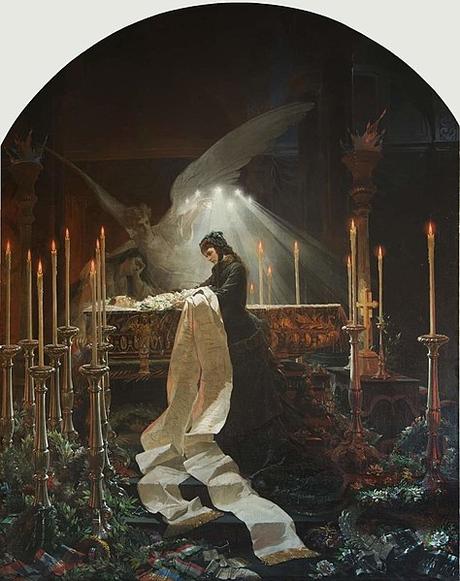 Collection Gödöllö PalaceElisabeth and Ferenc Deak according to Clara Tschudi
Collection Gödöllö PalaceElisabeth and Ferenc Deak according to Clara Tschudi Elisabeth's devotion to Hungary was apparent in her behaviour towards Franz Déak, to whom the country was indebted for a large share of its recovered freedom, though he persistently refused every offer of money that had been made to him in gratitude for his services.
The Queen took many opportunities of shewing kindness and friendship to the statesman, who became seriously ill in 1875. January 25th, 1876, she arrived at Buda from Munich , and her first question was addressed in the entrance hall to Bishop Rónay:
" How is Déak going on? ”
The reply was that he had evidently not long to live, when Elizabeth at once resolved to visit the sick man; though, with her usual tact and consideration, she waited to learn if she might be allowed to do so.
Crowds had gathered at the house of the great patriot when she arrived, who wanted to see for themselves her recognition of his services, and her present sympathy with him. Their silent greeting on this occasion was in its way not one whit less hearty than the “ eljen ” which usually welcomed her presence.
He died January 28th, and Elizabeth wept when the news was brought to her. His body lay in state in the great hall of the Academy, which had been converted into a chapelle ardente, and here Elizabeth came in one of the simplest court carriages, and dressed in deep mourning.
The deputies and ministers of Hungary were standing round the coffin when the Queen approached, carrying a wreath of laurel and white camellias, tied with a broad satin ribbon bearing the inscription:
" Erzsébet kyralynö Déak Ferencznek. ”
(“ From Queen Elizabeth to Franz Déak "). She stood for a few minutes in tearful silence by the lifeless body, and then turned to leave, when she suddenly went back, knelt on the lowest step, and prayed fervently.
The Hungarian painters, Munkacsy and Ziczy, have represented this scene , and a Hungarian author has written:
“ The memory of Déak is still glorified among us, but the tears of the Queen are the highest marks of honour that the dead hero could possibly receive. ”Le dernier hommage de la reine Elisabeth à Ferenc Deák par Clara TschudiLe dévouement d'Elisabeth à la Hongrie se manifeste dans son comportement envers Franz Déak, à qui le pays doit une grande partie de sa liberté retrouvée, bien qu'il ait refusé avec persistance toutes les offres d'argent qui lui ont été faites en remerciement de ses services.La Reine a saisi de nombreuses occasions de témoigner son amitié à l'homme d'État, qui était tombé gravement malade en 1875. Le 25 janvier 1876, elle arriva à Buda en provenance de Munich, et sa première question fut adressée dans le hall d'entrée à l'évêque Rónay :" Comment se porte Déak ? "On lui répondit qu'il n'en avait manifestement plus pour longtemps à vivre, et Élisabeth résolut aussitôt de rendre visite au malade ; mais, avec son tact et sa considération habituels, elle attendit qu'on lui assure qu'elle pourrait être autorisée à le faire.La foule qui voulait voir de ses propres yeux la reconnaissance de la reine aux services du patriote s'était rassemblée à la maison du grand patriote lorsqu'elle arriva. Leur salutation silencieuse en cette occasion n'était pas moins chaleureuse que le " eljen " qui accueillait habituellement sa présence.Il mourut le 28 janvier et Elizabeth pleura lorsqu'on lui annonça la nouvelle. Son corps fut exposé dans la grande salle de l'Académie, transformée en chapelle ardente, et Élisabeth s'y rendit en tenue de deuil dans l'un des plus simples carrosses de la cour.Les députés et les ministres de Hongrie étaient debout autour du cercueil lorsque la reine s'approcha, portant une couronne de laurier et de camélias blancs, attachée par un large ruban de satin portant l'inscription :" Erzsébet kyralynö Déak Ferencznek. "(" De la reine Élisabeth à Franz Déak "). Elle resta quelques minutes dans un silence larmoyant près du corps sans vie, puis s'apprêtait à partir, quand soudain elle revint en arrière, s'agenouilla sur la marche la plus basse etpria avec ferveur.Le peintre hongrois Ziczy areprésenté cette scène, et un auteur hongrois a écrit :" La mémoire de Déak est encore glorifiée parmi nous, mais les larmes de la Reine sont les plus hautes marques d'honneur que le héros mort puisse recevoir. "
